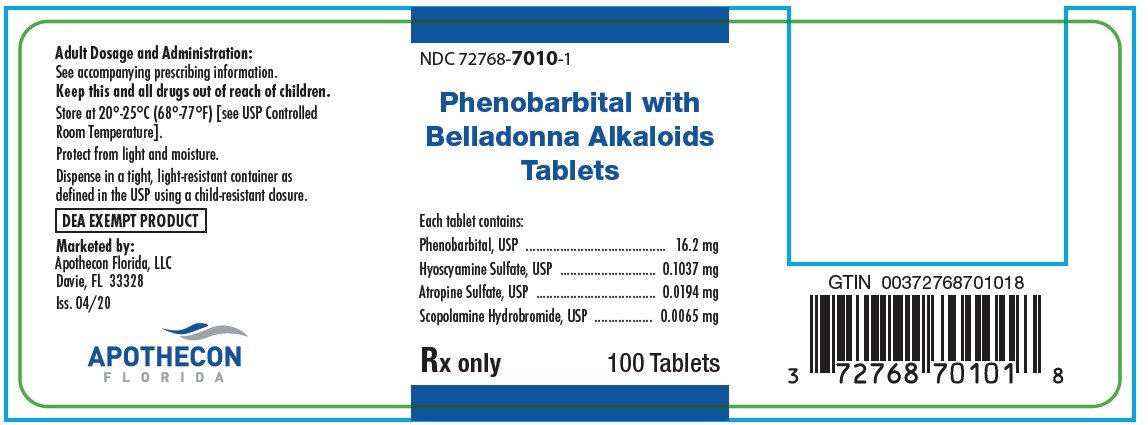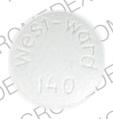Belladonna Alkaloids with Phenobarbital: Package Insert / Prescribing Info
Package insert / product label
Generic name: phenobarbital, hyoscyamine sulfate, atropine sulfate, scopolamine hydrobromide
Dosage form: tablet
Drug class: Anticholinergics / antispasmodics
Medically reviewed by Drugs.com. Last updated on Feb 24, 2025.
On This Page
Belladonna Alkaloids with Phenobarbital Description
Each Phenobarbital with Belladonna Alkaloids Tablet contains:
Phenobarbital, USP..... 16.2 mg
Hyoscyamine Sulfate, USP..... 0.1037 mg
Atropine Sulfate, USP .....0.0194 mg
Scopolamine Hydrobromide, USP .....0.0065 mg
Inactive Ingredients
Calcium Stearate, Colloidal Silicon Dioxide, Lactose, Microcrystalline Cellulose, and Pregelatinized Starch.
Belladonna Alkaloids with Phenobarbital - Clinical Pharmacology
This drug combination provides natural belladonna alkaloids in a specific, fixed ratio combined with phenobarbital to provide peripheral anticholinergic/antispasmodic action and mild sedation.
Indications and Usage for Belladonna Alkaloids with Phenobarbital
|
Based on a review of this drug by the National Academy of Sciences-National Research Council and/or other information, FDA has classified the indications as follows: "Possibly" effective: For use as adjunctive therapy in the treatment of irritable bowel syndrome (irritable colon, spastic colon, mucous colitis) and acute enterocolitis. May also be useful as adjunctive therapy in the treatment of duodenal ulcer. Final classification of the less-than-effective indications requires further investigation. IT HAS NOT BEEN SHOWN CONCLUSIVELY WHETHER ANTICHOLINERGIC/ANTISPASMODIC DRUGS AID IN THE HEALING OF A DUODENAL ULCER, DECREASE THE RATE OF RECURRENCES OR PREVENT COMPLICATIONS. |
Contraindications
- glaucoma;
- obstructive uropathy (for example, bladder neck obstruction due to prostatic hypertrophy);
- obstructive disease of the gastrointestinal tract (as in achalasia, pyloroduodenal stenosis, etc.);
- paralytic ileus, intestinal atony of the elderly or debilitated patient;
- unstable cardiovascular status in acute hemorrhage;
- severe ulcerative colitis especially if complicated by toxic megacolon;
- myasthenia gravis;
- hiatal hernia associated with reflux esophagitis;
- in patients with known hypersensitivity to any of the ingredients.
Phenobarbital is contraindicated in acute intermittent porphyria and in those patients in whom phenobarbital produces restlessness and/or excitement.
Warnings
Phenobarbital with Belladonna Alkaloids Tablets can cause fetal harm when administered to a pregnant woman. Animal reproduction studies have not been conducted with Phenobarbital with Belladonna Alkaloids Tablets. If this drug is used during pregnancy, or if the patient becomes pregnant while taking this drug, the patient should be apprised of the potential hazard to the fetus.
In the presence of a high environmental temperature, heat prostration can occur with belladonna alkaloids (fever and heatstroke due to decreased sweating).
Diarrhea may be an early symptom of incomplete intestinal obstruction, especially in patients with ileostomy or colostomy. In this instance, treatment with this drug would be inappropriate and possibly harmful.
Phenobarbital with Belladonna Alkaloids Tablets may produce drowsiness or blurred vision. The patient should be warned, should these occur, not to engage in activities requiring mental alertness, such as operating a motor vehicle or other machinery, and not to perform hazardous work.
Phenobarbital may decrease the effect of anticoagulants, and necessitate larger doses of the anticoagulant for optimal effect. When the phenobarbital is discontinued, the dose of the anticoagulant may have to be decreased.
Phenobarbital may be habit forming and should not be administered to individuals known to be addiction prone or to those with a history of physical and/or psychological dependence upon drugs.
Since barbiturates are metabolized in the liver, they should be used with caution and initial doses should be small in patients with hepatic dysfunction.
Precautions
General
Use with caution in patients with:
- autonomic neuropathy
- hepatic or renal disease
- hyperthyroidism
- coronary heart disease
- congestive heart failure
- cardiac arrhythmias
- tachycardia
- hypertension
Belladonna alkaloids may produce a delay in gastric emptying (antral stasis) which would complicate the management of gastric ulcer.
Do not rely on the use of the drug in the presence of complication of biliary tract disease.
Theoretically, with overdosage, a curare-like action may occur.
Information for Patients
Phenobarbital with Belladonna Alkaloids Tablets may produce drowsiness or blurred vision. The patient should be warned, should these occur, not to engage in activities requiring mental alertness, such as operating a motor vehicle or other machinery, and not to perform hazardous work.
Drug Interactions
Phenobarbital may decrease the effect of anticoagulants, and necessitate larger doses of the anticoagulant for optimal effect. When the phenobarbital is discontinued, the dose of the anticoagulant may have to be decreased.
Carcinogenesis, Mutagenesis, Impairment of Fertility
Long-term studies in animals have not been performed to evaluate carcinogenic potential.
Pregnancy
Animal reproduction studies have not been conducted with Phenobarbital with Belladonna Alkaloids Tablets. There is positive evidence of human fetal risk based on adverse reaction data from investigational or marketing experience or studies in humans, but potential benefits may warrant use of the drug in pregnant women despite potential risks (see WARNINGS).
Adverse Reactions/Side Effects
Adverse reactions may include xerostomia; urinary hesitancy and retention; blurred vision; tachycardia; palpitation; mydriasis; cycloplegia; increased ocular tension; loss of taste sense; headache; nervousness; drowsiness; weakness; dizziness; insomnia; nausea; vomiting; impotence; suppression of lactation; constipation; bloated feeling; musculoskeletal pain; severe allergic reaction or drug idiosyncrasies, including anaphylaxis, urticaria, and other dermal manifestations; and decreased sweating.
Acquired hypersensitivity to barbiturates consists chiefly in allergic reactions that occur especially in persons who tend to have asthma, urticaria, angioedema, and similar conditions. Hypersensitivity reactions in this category include localized swelling, particularly of the eyelids, cheeks, or lips, and erythematous dermatitis. Rarely, exfoliative dermatitis (e.g. Stevens-Johnson syndrome and toxic epidermal necrolysis) may be caused by phenobarbital and can prove fatal. The skin eruption may be associated with fever, delirium, and marked degenerative changes in the liver and other parenchymatous organs. In a few cases, megaloblastic anemia has been associated with the chronic use of phenobarbital.
Phenobarbital may produce excitement in some patients, rather than a sedative effect.
To report SUSPECTED ADVERSE REACTIONS, contact Apothecon Florida, LLC at 1-888-514-4727 or the FDA at 1-800-FDA-1088 or www.fda.gov/medwatch.
Drug Abuse and Dependence
Abuse
Phenobarbital may be habit forming and should not be administered to individuals known to be addiction prone or to those with a history of physical and/or psychological dependence upon drugs (see WARNINGS).
Overdosage
The signs and symptoms of overdose are headache, nausea, vomiting, blurred vision, dilated pupils, hot and dry skin, dizziness, dryness of the mouth, difficulty in swallowing, and CNS stimulation. Treatment should consist of gastric lavage, emetics, and activated charcoal. If indicated, parenteral cholinergic agents such as physostigmine or bethanechol chloride should be used.
Belladonna Alkaloids with Phenobarbital Dosage and Administration
The dosage of Phenobarbital with Belladonna Alkaloids Tablets should be adjusted to the needs of the individual patient to assure symptomatic control with a minimum of adverse effects.
Phenobarbital with Belladonna Alkaloids Tablets - Adults: One or two Phenobarbital with Belladonna Alkaloids Tablets three or four times a day according to condition and severity of symptoms.
How is Belladonna Alkaloids with Phenobarbital supplied
Phenobarbital with Belladonna Alkaloids Tablets are supplied as: White, round, convex tablet debossed with 'PBA' on one side and '7' on the other side.
-
Bottles of 100 tablets - NDC 72768-7010-1
Store at 20°-25°C (68°-77°F) [See USP Controlled Room Temperature]. Protect from light and moisture.
Dispense in a tight, light-resistant container as defined in the USP using a child-resistant closure.
DEA EXEMPT PRODUCT
Marketed by:
Apothecon Florida, LLC
Davie, FL 33328
Iss. 04/20
Principal Display Panel - 100 Tablets
NDC 72768-7010-1
Phenobarbital with Belladonna Alkaloids Tablets
Each tablet contains:
Phenobarbital, USP..... 16.2 mg
Hyoscyamine Sulfate, USP..... 0.1037 mg
Atropine Sulfate, USP .....0.0194 mg
Scopolamine Hydrobromide, USP .....0.0065 mg
Rx only 100 Tablets
Adult Dosage and Administration:
See accompanying prescribing information.
Keep this and all drugs out of reach of children.
Store at 20°-25°C (68°-77°F) [see USP Controlled Room Temperature].
Protect from light and moisture.
Dispense in a tight, light-resistant container as defined in the USP using a child-resistant closure.
DEA EXEMPT PRODUCT
Marketed by:
Apothecon Florida, LLC
Davie, FL 33328
Iss. 04/20

| PHENOBARBITAL WITH BELLADONNA ALKALOIDS
phenobarbital, hyoscyamine sulfate, atropine sulfate, scopolamine hydrobromide tablet |
||||||||||||||||||
|
||||||||||||||||||
|
||||||||||||||||||
|
||||||||||||||||||
|
||||||||||||||||||
|
||||||||||||||||||
|
||||||||||||||||||
| Labeler - Apothecon Florida, LLC (116880206) |
More about atropine / hyoscyamine / phenobarbital / scopolamine
- Check interactions
- Compare alternatives
- Pricing & coupons
- Reviews (62)
- Drug images
- Side effects
- Dosage information
- During pregnancy
- Drug class: anticholinergics/antispasmodics
Patient resources
Professional resources
- Phenobarbital with Belladonna Alkaloids Elixir prescribing information
- Phenobarbital, Hyoscyamine Sulfate, Atropine Sulfate and Scopolamine Hydrobromide Elixir (FDA)
- Phenobarbital, Hyoscyamine Sulfate, Atropine Sulfate and Scopolamine Hydrobromide Tablets (FDA)

